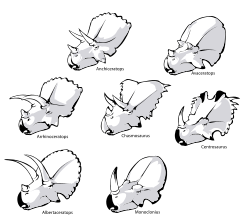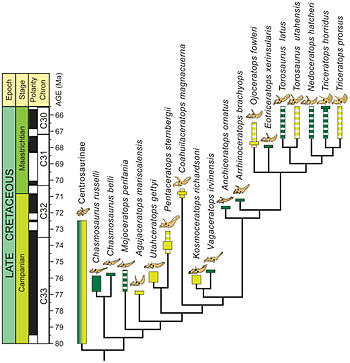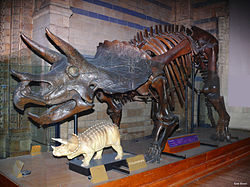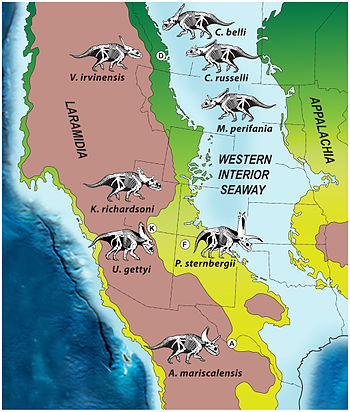- Ceratopsidae
-
Ceratopsids
Temporal range: Late Cretaceous, 90–65 Ma
Ceratopsid heads Scientific classification 
Kingdom: Animalia Phylum: Chordata Class: Reptilia Superorder: Dinosauria Order: †Ornithischia Suborder: †Ceratopsia Superfamily: †Ceratopsoidea Family: †Ceratopsidae
Marsh, 1890Type species †Ceratops montanus
Marsh, 1888Subgroups Synonyms Ceratopsidae (sometimes spelled Ceratopidae) is a speciose group of marginocephalian dinosaurs including Triceratops and Styracosaurus. All known species were quadrupedal herbivores from the Upper Cretaceous, mainly of Western North America (though Turanoceratops and Sinoceratops are known from Asia)[1][2] and are characterized by beaks, rows of shearing teeth in the back of the jaw, and elaborate horns and frills. The group is divided into two subfamilies. The Ceratopsinae or Chasmosaurinae are generally characterized by long, triangular frills and well-developed brow horns. The Centrosaurinae had well-developed nasal horns or nasal bosses, shorter and more rectangular frills, and elaborate spines on the back of the frill.
These horns and frills show remarkable variation and are the principal means by which the various species have been recognized. Their purpose is not entirely clear. Defense against predators is one possible purpose – although the frills are comparatively fragile in many species – but it is more likely that, as in modern ungulates, they may have been secondary sexual characteristics used in displays or for intraspecific combat. The massive bosses on the skulls of Pachyrhinosaurus and Achelousaurus resemble those formed by the base of the horns in modern musk oxen, suggesting that they may have butted heads. Centrosaurines have frequently been found in massive bone beds with few other species present, suggesting that the animals might have lived in large herds.
Contents
Taxonomy
 Phylogeny of the Ceratopsinae from Sampson et al. (2010)[3]
Phylogeny of the Ceratopsinae from Sampson et al. (2010)[3]
- Family Ceratopsidae
- Subfamily Centrosaurinae
- Achelousaurus - (Montana, USA)
- Albertaceratops - (Alberta, Canada & ?Montana, USA)
- ? Avaceratops - (Montana, USA)
- Brachyceratops - (Montana, USA & Alberta, Canada)
- Centrosaurus - (Alberta, Canada)
- Diabloceratops - (Montana, USA)
- Einiosaurus - (Montana, USA)
- Monoclonius - (Montana, USA & Alberta, Canada)
- Pachyrhinosaurus- (Alberta, Canada & Alaska, USA)
- Rubeosaurus - (Montana, USA)
- Sinoceratops - (Shandong, China)
- Styracosaurus - (Alberta, Canada & Montana, USA)
- Subfamily Ceratopsinae
- Ceratops - (Montana, USA & Alberta, Canada)
- Subfamily Chasmosaurinae
- Agathaumas - (Wyoming, USA)
- Agujaceratops - (Texas, USA)
- Anchiceratops - (Alberta, Canada)
- Arrhinoceratops - (Alberta, Canada)
- Chasmosaurus - (Alberta, Canada)
- Coahuilaceratops - (Coahuila, Mexico)
- ? Dysganus - (Montana, USA)
- Kosmoceratops - (Utah, USA)
- Medusaceratops - (Montana, USA)
- Mojoceratops - (Alberta & Saskatchewan, Canada)
- Pentaceratops - (New Mexico, USA)
- ? Polyonax - (Colorado, USA)
- ? Turanoceratops - (Uzbekistan)
- Utahceratops - (Utah, USA)
- Vagaceratops - (Alberta, Canada)
- Tribe Triceratopsini
- Eotriceratops - (Alberta, Canada)
- Ojoceratops - (New Mexico, USA)
- Tatankaceratops - (South Dakota, USA)
- Titanoceratops - (New Mexico, USA)
- Torosaurus - (Wyoming, Montana, South Dakota, North Dakota, & Utah, USA & Saskatchewan, Canada)
- Triceratops - (Montana & Wyoming, USA & Saskatchewan & Alberta, Canada)
- Subfamily Centrosaurinae
Behavior
Social behavior
In 2001 paleontologist Scott D. Sampson published a study speculating on the socioecology of ceratopsid dinosaurs in the light of correlations between anatomy and behavior in extant wildlife observed by earlier researchers.[4] Ceratopsid social behavior had been controversial with some authors envisioning large "socially complex" herds represented by bone beds in the fossil record and some like Lehman arguing that such aggregations of individuals amounted to regional infestations as sometimes occurs with modern tortoises and crocodiles.[5]
Sampson argues in favor of complex herding using the socioecology of modern ecological and anatomical ceratopsian analogues.[5] A biologist named Jarman observed among modern ungulates correlations between "ecological variables including feeding style, body size, group size, home range, antipredator behavior, growth pattern, and social organization."[6] He speculated that a taxon's social organization was effected by the distribution of resources through the effect that distribution had on the dispersion of conspecific females throughout the environment.[6] Herding is normal in environments where resources are less predictable, while territoriality tends to evolve in environments with a more consistent distribution of resources.[7] Ceratopsids feature both prominent mating signals (horns and frills) and at least periodic gregarious behaviors.[8] Ceratopsians may have been only social during the dry season and scattered when the rainy season started.[9] Many African herding animals do this today.[9] Ceratopsid bone beds tend to come from more inland environments than other ceratopsian remains.[9] Other workers had concluded that for part of the year ceratopsids lived in small groups near the coasts and when the dry season came they formed large herds and moved inland.[9] This migration away from the coasts may have represented a move to nesting grounds.[9]
Sampson found in previous work that at least centrosaurines did not achieve adult morphology with its accompanying mating signals until nearly fully grown.[10] Relative age of the animals was determined based on the size, degree of coossification, secondary ossification, and growth related changes in bone texture.[10] Sampson finds commonality between the retarded growth of mating signals in centrosaurines and the extended adolescence of animals whose social structures are ranked hierarchies founded on age-related differences.[10] In these sorts of groups young males are typically sexually mature for several years before actually beginning to breed, when their mating signals are most fully developed.[11] Females, by contrast do not have such an extended adolescence.[11]
Lehman had previously argued that the higher diversities of species and population densities supported the notions that ceratopsid bone beds were left by temporary infestations lacking in social structure like in crocodiles and tortoises.[12] However, Sampson observes that crocodiles themselves actually show complex behavioral hierarchies.[12] He also notes that some modern herding mammals, at least occasionally, form groups denser than those hinted at by ceratopsid bone beds.[12] Herds would also have afforded some level of protection from the chief predators of ceratopsids, tyrannosaurids.[13]
Migration
Some paleontologists have concluded that for part of the year ceratopsids lived in small groups near the coasts and when the dry season came they formed large herds and moved inland.[9] This migration away from the coasts may have represented a move to nesting grounds.[9]
Paleobiology
Development
Sampson found in previous work that at least centrosaurines did not achieve adult morphology with its accompanying mating signals until nearly fully grown.[10] Relative age of the animals was determined based on the size, degree of coossification, secondary ossification, and growth related changes in bone texture.[10] Sampson finds commonality between the retarded growth of mating signals in centrosaurines and the extended adolescence of animals whose social structures are ranked hierarchies founded on age-related differences.[10] In these sorts of groups young males are typically sexually mature for several years before actually beginning to breed, when their mating signals are most fully developed.[11] Females, by contrast do not have such an extended adolescence.[11]
Diet
Ceratopsids were adapted to processing high-fiber plant material with their highly derived dental batteries.[14] They may have utilized fermentation to break down plant material with a gut microflora.[14]
Physiology
Main article: Dinosaur physiologyCeratopsians probably had the "low mass-specific metabolic rat[e]" typical of large bodied animals.[14]
Sexual dimorphism
 Skeleton of Triceratops in London's Natural History Museum. Triceratops is the best known Ceratopsid and of the largest of them.
Skeleton of Triceratops in London's Natural History Museum. Triceratops is the best known Ceratopsid and of the largest of them.
If ceratopsids were to have sexual dimorphism modern ecological analogues suggest it would be in their mating signals like horns and frills.[15] No convincing evidence for sexual dimorphism in body size or mating signals is known in ceratopsids, although was present in the more primitive ceratopsian Protoceratops andrewsi whose sexes were distinguishable based on frill and nasal prominence size.[15] This is consistent with other known tetrapod groups where midsized animals tended to exhibit markedly more sexual dimorphism than larger ones.[16] However, if there were sexually dimorphic traits they may have been soft tissue variations like colorations or dewlaps that would not have been preserved as fossils.[16]
Reproduction
Some paleontologists have concluded that for part of the year ceratopsids lived in small groups near the coasts and when the dry season came they formed large herds and moved inland.[9] This migration away from the coasts may have represented a move to nesting grounds.[9] Centrosaurines may have participated in social structures with ranked hierarchies founded on age-related differences.[10] If so, young male centrosaurines would probably be sexually mature for several years before actually beginning to breed, when their mating signals are most fully developed.[11] Females, by contrast do not have such an extended adolescence.[11]
Evolution
The evolution of ceratopsid dinosaur shares characteristics with the evolution of some mammal groups, both were "geologically brief" events precipitating the simultaneous evolution of large body size, derived feeding structures, and "varied hornlike organs."[5]
Paleoecology
The chief predators of ceratopsids were tyrannosaurids.[13]
Preservation
Bone beds
Ceratopsid bone beds tend to come from more inland environments than other ceratopsian remains.[9] Lehman had previously argued that the higher diversities of species and population densities supported the notions that ceratopsid bone beds were left by temporary infestations lacking in social structure like in crocodiles and tortoises.[12] However, Sampson observes that crocodiles themselves actually show complex behavioral hierarchies.[12] He also notes that some modern herding mammals, at least occasionally, form groups denser than those hinted at by ceratopsid bone beds.[12] Herds would also have afforded some level of protection from the chief predators of ceratopsids, tyrannosaurids.[13]
Footnotes
- ^ Sues, H.-D., and Averianov, A. (2009). "Turanoceratops tardabilis—the first ceratopsid dinosaur from Asia." Naturwissenschaften, doi:10.1007/s00114-009-0518-9
- ^ Xu, X., Wang, K., Zhao, X. & Li, D. (2010). "First ceratopsid dinosaur from China and its biogeographical implications". Chinese Science Bulletin 55: 1631–1635. doi:10.1007/s11434-009-3614-5.
- ^ a b Scott D. Sampson, Mark A. Loewen, Andrew A. Farke, Eric M. Roberts, Catherine A. Forster, Joshua A. Smith, and Alan L. Titus (2010). "New Horned Dinosaurs from Utah Provide Evidence for Intracontinental Dinosaur Endemism". PLoS ONE 5 (9): e12292. doi:10.1371/journal.pone.0012292. PMC 2929175. PMID 20877459. http://www.plosone.org/article/info%3Adoi%2F10.1371%2Fjournal.pone.0012292.
- ^ "Abstract," Sampson (2001); page 263.
- ^ a b c "Introduction," Sampson (2001); page 264.
- ^ a b "Sociological Correlates in Extant Vertebrates," Sampson (2001); page 264.
- ^ "Sociological Correlates in Extant Vertebrates," Sampson (2001); page 266.
- ^ "Ceratopsid Socioecology," Sampson (2001); pages 267-268.
- ^ a b c d e f g h i j "Resource Exploitation and Habitat," Sampson (2001); page 269.
- ^ a b c d e f g "Retarded Growth of Mating Signals," Sampson (2001); page 270.
- ^ a b c d e f "Sociological Correlates in Extant Vertebrates," Sampson (2001); page 265.
- ^ a b c d e f "Social Organization: Herds or Infestations?," Sampson (2001); page 271.
- ^ a b c "Predation Pressure," Sampson (2001); page 272.
- ^ a b c "Resource Exploitation and Habitat," Sampson (2001); page 268.
- ^ a b "Sexual Dimorphism," Sampson (2001); page 269.
- ^ a b "Sexual Dimorphism," Sampson (2001); page 270.
References
- Dodson, P. (1996). The Horned Dinosaurs. Princeton University Press, Pinceton, New Jersey, pp. xiv-346
- Dodson, P., & Currie, P. J. (1990). "Neoceratopsia." 593-618 in Weishampel, D. B., Dodson, P., & Osmólska, H. (eds.), 1990: The Dinosauria. University of California Press, Berkley, Los Angeles, Oxford, 1990 xvi-733.
- Sampson, S. D., 2001, Speculations on the socioecology of Ceratopsid dinosaurs (Orinthischia: Neoceratopsia): In: Mesozoic Vertebrate Life, edited by Tanke, D. H., and Carpenter, K., Indiana University Press, pp. 263–276.
External links
- Ceratopidae at DinoData
Categories:- Ceratopsians
- Ceratopsids
- Family Ceratopsidae
Wikimedia Foundation. 2010.



